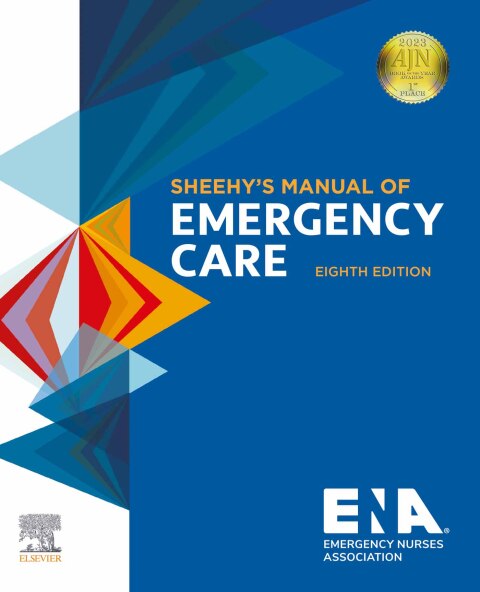Description
Efnisyfirlit
- Cover image
- Title page
- Table of Contents
- Inside Front Cover
- Copyright
- Dedication
- Contributors
- Seventh edition Contributors
- Reviewers
- Preface
- Acknowledgments
- Section 1: Basic Emergency Issues
- 1: Legal Considerations
- Nurse practice acts
- Delegation and unlicensed assistive personnel
- Negligence and malpractice
- Confidentiality and HIPAA regulations
- Mandated reporting
- EMTALA and interfacility transfers
- Consent
- Documentation
- Use of restraints
- Advanced directives
- Forensics: evidence collection and preservation
- Legal considerations summary
- References
- 2: Ethical Considerations
- Principles of Medical Ethics1–3
- Ethical Frameworks4
- Code of Ethics
- Decision-making
- Selected Ethical Situations
- Moral Distress in Emergency Nursing
- Ethical Considerations Summary
- References
- 3: Workplace Violence
- Violence Statistics1,2
- Emergency Nursing Violence Statistics
- Definitions of Violence
- Bullying and Lateral Violence
- Violence Prevention Regulation
- Elements of a Violence Prevention Program
- Risk Factors for Violence
- Violence Prevention Education
- Clinical Violence Risk Assessments
- Responding to Violence
- Active Shooter Situations
- Flagging
- Reporting Violent Incidents
- The Aftermath: Supporting Caregivers after Violence
- Workplace Violence Summary
- References
- 4: Patient Safety
- What is Patient Safety?
- Building a Culture of Safety
- Reporting Errors
- System Challenges
- Pediatric Safety Considerations
- Disruptive Behavior
- Patient Safety Summary
- References
- 5: Disaster Considerations
- Types of disasters
- Disaster framework
- Emergency preparedness background
- National incident management system
- Planning and analysis
- Training and education
- Mitigation
- Preparedness
- Response
- Methods of disaster triage
- Hazardous materials (hazmat) considerations
- Crisis standards of care
- Demobilization
- Disaster mental health
- Disaster considerations summary
- References
- 6: Infectious Diseases
- Isolation precautions1,2
- Blood-borne infections
- Airborne infections
- Water-borne and food-borne infections
- Vector-borne infections
- Dermal infections
- Other selected infection emergencies
- Infectious disease summary
- References
- 7: Triage
- Emergency medical treatment and active labor act
- Consent for treatment
- Triage qualifications
- Triage process
- Valid and reliable triage acuity systems
- Triage “modifications”
- Clinical decision support
- Managing the waiting room
- Triage care and diagnostics
- Special triage situations
- Triage summary
- References
- 8: Care of the Patient With Pain
- Types of pain
- Pain assessment
- Discharge of patients prescribed opioid analgesia
- Providing comfort for the patient in pain
- Emergency pain management summary
- References
- 9: Forensic Considerations
- Basics of forensics
- Classification of evidence
- Uses of evidence
- Evidence collection and preservation
- Handling and disposition of evidence
- Forensics of injuries
- Selected types of evidence
- Forensic nursing opportunities
- Forensic considerations summary
- References
- 10: Patient Care Management
- Initial assessment
- Handoff
- Patient care management summary
- References
- Section 2: Medical and Traumatic Emergencies
- 11: Respiratory Emergencies
- Airway and ventilation assessment
- History
- Respiratory assessment
- Airway management
- Ventilation management
- Selected airway emergencies
- Selected respiratory emergencies
- Respiratory emergencies summary
- References
- 12: Cardiovascular Emergencies
- Assessment of chest pain
- General cardiac diagnostic procedures and interventions4
- Selected cardiac emergencies
- Cardiovascular emergencies summary
- References
- 13: Cardiopulmonary Arrest
- Management of cardiopulmonary arrest
- The team approach
- Family presence during resuscitation
- Selected causes of cardiac arrest
- Patient management following successful resuscitation
- Cardiopulmonary arrest summary
- References
- 14: Chest Trauma
- Selected immediately life-threatening chest injuries
- Selected potentially life-threatening chest trauma
- Selected non–life-threatening chest trauma
- Chest trauma summary
- References
- 15: Shock Emergencies
- Pathophysiology
- Stages of shock
- Monitoring the patient in shock
- Types of shock
- End points of shock resuscitation
- Shock summary
- References
- 16: Neurologic Emergencies
- Neurologic assessment
- Selected neurologic emergencies
- Neurologic emergencies summary
- References
- 17: Head, Neck, and Vertebral Column Trauma
- Trauma to the head
- Trauma to the neck
- Trauma to the vertebral column
- Cerebral perfusion principles
- Physical assessment of the neurologically injured patient
- General diagnostics and interventions
- Selected head injuries
- Selected neck injuries
- Selected vertebral and spinal cord injuries
- Head, neck, and vertebral column trauma summary
- References
- 18: Facial, Ocular, ENT, and Dental Emergencies
- Selected facial emergencies
- Selected eye emergencies
- Selected ear, nose, throat emergencies
- Selected dental emergencies
- Body piercing of the face, ears, and tongue
- Facial, ocular, ent, and dental emergencies summary
- References
- 19: Facial, Ocular, ENT, and Dental Trauma
- Primary assessment
- Secondary assessment
- Facial soft tissue trauma6
- Auricular trauma
- Facial fractures
- Dental trauma
- Ocular trauma9
- Facial, ocular, ENT, and dental trauma summary
- References
- 20: Abdominal and Genitourinary Emergencies
- Initial evaluation
- Selected abdominal emergencies
- Selected genitourinary emergencies
- Selected genitourinary problems unique to male anatomy
- Selected emergencies in dialysis patients2,3
- Abdominal and genitourinary emergencies summary
- References
- 21: Abdominal and Genitourinary Trauma
- Blunt trauma
- Penetrating trauma
- Physical assessment of the abdomen1–3
- Diagnostic procedures
- Therapeutic interventions1–3
- Selected abdominal organ injuries
- The pregnant patient with abdominal trauma1–3,9,10
- Abdominal and genitourinary trauma summary
- References
- 22: Obstetric and Gynecologic Emergencies
- Selected complications of pregnancy
- Emergent delivery
- Complications of delivery
- Nonpregnancy-related abdominal pain
- Obstetric and gynecologic emergencies summary
- References
- 23: Obstetric and Gynecologic Trauma
- Assessment of the obstetric trauma patient
- Selected obstetric traumatic emergencies
- Obstetric and gynecologic trauma summary
- References
- 24: Sexually Transmitted Infections
- Patient history and assessment
- Selected sexually transmitted infection emergencies
- Sexually transmitted infection summary
- References
- 25: Musculoskeletal Trauma
- Initial assessment
- Emergency care of an injured extremity
- Selected musculoskeletal injuries
- Musculoskeletal trauma summary
- References
- 26: Wound Management
- General wound management
- Wound healing
- Wound assessment
- Wound management considerations
- Wound management for selected injuries
- Wound emergencies summary
- References
- 27: Burn Trauma
- Etiology
- Pathophysiology
- Primary survey and selected injuries
- Burn severity: depth and extent
- Fluid resuscitation
- Determine need for transfer to burn center
- Secondary assessment
- Pain management
- Wound care
- Additional interventions for burns
- Assessing for maltreatment
- Burn trauma summary
- References
- 28: Interpersonal Violence and Abuse
- Facts and information
- Types of maltreatment
- Mandatory reporting for protected populations
- Examination for interpersonal violence
- Therapeutic interventions
- Advocacy and support services
- Safety plan and discharge
- Documentation
- Factitious disorder imposed on another
- Child maltreatment
- Child sexual assault material
- Adverse childhood experiences
- Human trafficking
- Intimate partner violence
- Strangulation
- Maltreatment concerns for the LGBTQIA+ community
- Elder and dependent/incapacitated adult abuse
- Interpersonal violence and abuse summary
- References
- 29: Sexual Assault
- General approach
- Sexual assault nurse examiner
- Triage
- Primary assessment
- History
- Physical assessment
- Basic principles of sexual assault evidence collection
- Evidence preservation11
- Forensic toxicology
- Documentation
- Forensic photography
- Chain of custody
- Diagnostic procedures
- Therapeutic interventions
- Emotional and mental health well-being
- Discharge and followup care
- Sexual assault summary
- References
- 30: Environmental Emergencies
- Hypothermia1,2
- Selected cold-induced injuries
- Selected heat-induced illnesses
- Lightning injuries
- Diving emergencies
- High-altitude pulmonary edema16,17
- Environmental emergencies summary
- References
- 31: Bite and Sting Emergencies
- Rabies
- Tick-borne illnesses
- Snakebites
- Spider (arachnid) bites
- Scorpion stings
- Bee, wasp, hornet, and fire ant stings19
- Marine bites and envenomations
- Bite and sting emergencies summary
- References
- 32: Metabolic Emergencies
- Selected diabetic emergencies
- Selected pituitary emergencies
- Selected thyroid emergencies
- Selected adrenal emergencies
- Selected electrolyte emergencies
- Metabolic emergencies summary
- References
- 33: Hematologic, Oncologic, and Immunologic Emergencies
- Hematologic emergencies
- Hematologic malignancies
- Oncologic emergencies
- Immunologic emergencies
- Hematologic, oncologic, and immunologic emergencies summary
- References
- 34: Toxicologic Emergencies
- General priorities for known or suspected poisoned patients
- Identifying the poison
- Therapeutic interventions for poisonings and overdoses
- Selected toxicologic emergencies
- Prevention and education
- Toxicological emergencies summary
- References
- 35: Substance Abuse and Addiction Emergencies
- Changing the culture
- Drug and alcohol emergencies
- Opioids
- Stimulants (sympathomimetics)
- Cannabis
- Designer drugs: novel psychoactive substances
- Hallucinogens and dissociative drugs
- Inhalants
- Alcohol
- Substance abuse and addiction disease summary
- References
- Section 3: Special Population Considerations
- 36: Critical Care in the Emergency Department
- Approach to ongoing critical care
- Airway and breathing
- Circulation
- Neurological
- Family engagement
- Diagnostic studies
- Resources
- Critical care in the emergency department summary
- References
- 37: Palliative Care and End-of-Life Considerations
- Palliative care1
- Hospice care2
- End-of-life decisions
- Selected end-of-life emergencies
- Organ and tissue donation
- Death notification and postmortem care
- Pediatric death
- Palliative care and end-of-life considerations summary
- References
- 38: Pediatric Emergency and Trauma Considerations
- Pediatric triage
- Medication administration and intravenous therapy
- Selected pediatric emergencies
- Pediatric trauma assessment and treatment
- Selected traumatic pediatric injuries
- Prevention of pediatric trauma
- Pediatric emergency and trauma summary
- References
- 39: Mental Health Emergencies
- Mental health triage
- Mental health assessment
- General approach to the patient
- Mental health emergencies without psychoses
- Mental health emergencies with psychoses
- The violent patient
- Mental health emergencies due to a medical or neurologic disorder
- Drug-related mental health emergencies
- Adverse reactions to psychiatric medications
- Pediatric mental health emergencies
- Mental health patient disposition
- Mental health emergencies summary
- References
- 40: Considerations for the Patient With Morbid Obesity
- Assessing and treating special needs of the patient with morbid obesity
- Staff safety
- Healthcare risk for the obese population
- Pediatric considerations
- Healthcare risks for the obese pediatric population
- Considerations for the patient with morbid obesity: summary
- References
- 41: Considerations for the Gender-Diverse Patient
- Gender-related definitions and terminology
- Communication approaches
- Assessment
- Diagnostic studies
- Therapeutic Interventions
- Gender dysphoria and depression
- Suicidal thoughts and ideations
- Human trafficking
- Gender-diverse patient consideration summary
- References
- 42: Geriatric Emergency and Trauma Considerations
- Geriatric emergencies
- Geriatric trauma
- Geriatric considerations summary
- References
- Index







Reviews
There are no reviews yet.